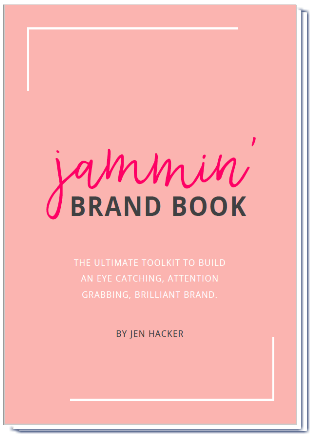A hard look at why your brand isn’t taking off like you’d imagined
.png)
Here’s a real question for you. What were some of the biggest fears you had around launching your brand? Maybe they’re even fears you currently have as you prepare for that launch.
Do any of these sound familiar?
- I’m afraid no one will care or pay attention.
- I’m afraid my products/services won’t sell.
- I’m afraid of what people will think.
If everyone reading this was in a room together I’m sure 99% of hands would be in the air. Because let’s face it, these are all things that we should fear. After all, we put so much work into bringing our dreams to life, we sure as heck want to see our brands to succeed.
So what do we do when some of those fears actually start to become our realities? Do we throw in the towel and call it quits? I sure hope not! Instead, we can take a good honest look at where we might have missed the marks.
I’ve worked with many brands in my career and have seen some common patterns emerge. In this post, I’m sharing 4 of the top reasons that your brand might not be taking off like you like, and how to start diagnosing the problems.
Alright, let’s get to it!
1. It’s not clear what your brand does
When you are building your brand one of the most important questions you’ll need to answer is, “what do you do?”. It seems deceptively simple. Yet so many new business owners get it wrong.
Your response should address these three questions:
- What primary product or service do you sell?
- Who is the perfect customer for this product or service?
- Why is your product or service the perfect one for them?
Let’s take a look at a few examples:
- Glossier: Glossier makes easy-to-use skincare and makeup that form the backbone to a cool girl’s unique beauty routine.
- Lunya: Lunya creates effortless & comfortable sleepwear built for function & flattery for today’s modern woman.
- Brit + Co: Brit+ Co is a media company that inspires, educates and entertains real women with a creative spirit.
Can you see how each these examples provides a clear response to the three questions we outlined? They’re incredibly focused and that’s what makes them work.
So how can you tell if your brand is confusing people? Here are three things to investigate:
- Search result description. Type your brand name into Google. Now, read the description that shows up for your website. Does it clearly answer the question, “what do you do?” or, have you neglected to format this into a response that is immediately understandable.
- Brand name. Consider the name you’ve chosen for your brand. Is it descriptive of what your brand does? If not, have you written a thoughtful strapline to accompany it and provide more context? For instance, Coolhaus: Awesome Ice Creams.
- Word choice. Ask a close friend who knows your business to describe what you do. Are the words she uses the same that you use? You want to remember that your customers aren’t going to be as familiar with your industry lingo as you are. So rather than trying to impress them with fancy words, explain what you do in the words they would use.
2. Your brand website looks wack
When someone learns about your brand one of the first things they will do is Google it. Honestly, it’s just become human nature at this point. People will want to look you up and see what you’re all about. What they find, well, that is going to set the tone for how positively they perceive your brand.
First things first, yes your brand should have a website – and no, a Facebook page does not count. Beyond that, let’s take a look at a few mistakes you might be making that can seriously throw off your game:
- Your pictures are… meh. People form a first impression within seconds of landing on your brand’s website. That big image you have at the top of your homepage, it matters more than you think. The pictures on your website need to look professional meaning they are well composed, properly lit, and hi-res. Stock photos are fine but you’ll want to invest in ones that actually fit your branding.
- You lack style. Open up your website. Is there a clear color scheme to it? When someone thinks of your brand does a signature color even come to mind? How about your fonts? Have you developed a clean fonts system with specific choices for things like headlines, body copy, and buttons? Or are you simply using whatever the default was in your website’s theme? It’s important to put thought into your appearance if you want to be perceived as a brand to be taken seriously.
- Your domain isn’t your brand name. At a bare minimum, your website needs a unique domain. WordPress, Squarespace, Wix, Shopify or anything akin to this should not be in your website’s address. Period. The very best case is that your website URL (www.brandname.com) matches your brand name. If that domain is not available, you want to get as close to it as possible.
- You haven’t changed the favicon. A favicon is the tiny image that appears when you open up a new tab in Chrome or another browser. Your website builder (WordPress, Squarespace, Wix, etc…) will default to their logo. That looks amateur. To elevate your brand, make sure you have switched this to a favicon version of your own logo.
Think of it like this, your website is your brand’s online home. It’s a place for you to welcome people and invite them in to get to know you. You wouldn’t want guests coming over to your real home if you had dishes in the sink, dirty laundry strewn about, and garbage piling up. You also wouldn’t give them the wrong address and expect them to magically find where you live. The space principles apply to your brand’s home.
3. Your brand’s Instagram feed is all over the place
Instagram provides another place beyond our website for customers to connect with us. It’s grown into a critical platform for engaging fans and building a community. In fact, research has shown that consumers are more likely to purchase from a brand they follow on social media than from one they do not.
For many brands, Instagram is the platform of choice attracting the attention of their ideal audience. That means we have to treat it like a true extension of our brand and not simply as a nice place to post.
If you find that you’re failing to grow your following or get engagement from the fans that are there, here are a few reasons that might be behind it:
- No clear color scheme. Your feed needs to look cohesive. When you look at your grid (e.g. the 9 images that show at any given time) they need to almost blend into one complete picture. The way that you achieve this look is by developing a clear style to your images. You should only be posting images that are in your brand colors and you want to use the same filter or editing steps across all.
- Inconsistent content. You need to give your customers a reason to follow you. They need to have a general idea of what kinds of content that you are going to post. You shouldn’t be sharing an inspirational quote one day, a photo of your dog the next, and a picture of an event flyer the day after. It makes your feed look inconsistent and messy. Instead, you want to choose 3 – 5 key themes to post around that are relevant to your brand and to your customers.
- Generic captions. While it’s your images that will pull people in, it’s your captions that will get them talking. This space should be used to give context to the image, to show off your brand personality, and to create a conversation with your customers. You have to think beyond “Happy Friday!” “On sale now!” and “#summer #yay”. Put thought and purpose into what you write.
- Promotion overload. Your feed is not your storefront. I repeat, your feed is not your storefront. People don’t want to be hit over the head with sales. That is not a reason for them to follow you. Follow the 80/20 rule. Share posts that are entertaining, educational, or inspirational 80% of the time and reserve your product, promotion, and announcement posts for the remaining 20 %.
4. You aren’t focusing on your customer
Have you heard that the best way to get people talking is to let them talk about themselves? It’s an important notion to not only bear in mind when walking into a party but also when building your brand. You want your focus to be on your customers, not yourself. They will tell you so much if you only take the time to listen to what they have to say.
It’s my bet that this isn’t the first time you’ve been told that it’s important to know who your customers are. You also probably already know that it’s important to take the time to get to know them. Given that, why might you feel like you are still struggling to really connect with them? Here are a few reasons that might be the culprit behind the chasm:
- Your website copy talks about features vs. benefits. Features focus on what your brand has to offer. Authentic textures, original designs, great taste, *special ingredient* — these are examples of features. Benefits on the other hand focus on what your customer has to gain. Increased energy, reduced anxiety, better health, a clear conscious — these are examples of benefits. While you may care about the former, your customers care about the latter.
- You use lingo and language they don’t understand. Drop the jargon. Your customers don’t get it nor do they care. You are deeply rooted in your industry and have learned every nuance. Your customer has not. Talk to them in a way they’ll understand.
- You don’t understand their real pain point/desires. The products and services you offer have to offer a solution to a real problem or pain point your customer has. To take that even further, you need to talk to them about why and how it addresses that pain point and offers them their desired solution. Your copy can’t just tout great benefits. Those benefits have to be the ones your customers actually care about.
- Your images don’t feature your customers. It’s much easier to become what we can see. You want to depict your perfect customer in the images you use on your website, social media feeds, and collateral. It’s going to help them understand that your brand is for someone like them.
On to you…
Do any of these reasons hit the mark for you? Which ones do you think are the reason your brand isn’t taking off like you’d like? Any other theories you’d add? Let me know in the comments below!





























